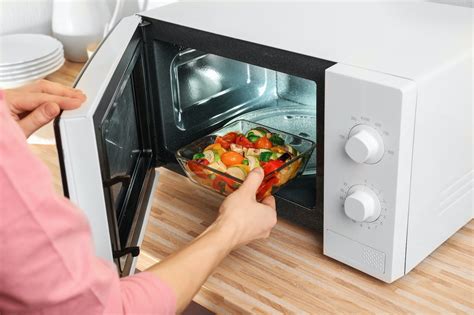Microwaves have become ubiquitous in modern kitchens, offering a quick and convenient way to heat food. However, not all dishes are created equal when it comes to microwave safety. Choosing the right microwave-safe dishes is crucial to avoid potential hazards and ensure the longevity of your microwave. This comprehensive guide will delve into the world of microwave-safe dishes, empowering you with the knowledge to make informed choices.

Understanding Microwave-Safe Materials
Microwave-safe dishes are made from materials that allow microwave energy to penetrate and heat the food without damaging the dish. These materials include:
- Ceramic: Ceramic dishes are heat-resistant and durable, making them an excellent choice for microwaving. They can reach high temperatures without cracking or breaking.
- Glass: Glass is another heat-resistant material that is suitable for microwaving. However, it is important to use tempered glass that is specifically designed for microwave use, as regular glass can shatter under the intense heat.
- Plastic: Certain types of plastic, such as polyethylene terephthalate (PETE) and polypropylene (PP), can withstand microwave heat. Look for the microwave-safe symbol on plastic containers to ensure their safety.
- Paper: Paper plates and bowls are generally microwave-safe, but they may become soggy or burn if heated for too long.
Avoiding Microwave-Unsafe Materials
Some materials should never be used in a microwave, as they can cause serious problems. These include:
- Metal: Metal reflects microwave energy, causing sparks and potentially damaging the microwave.
- Foil: Aluminum foil can cause arcing and even fire in a microwave.
- Styrofoam: Styrofoam containers may melt or release toxic fumes when microwaved.
- Wood: Wood can catch fire in a microwave.
- Wax paper: Wax paper can catch fire in a microwave.
Identifying Microwave-Safe Dishes
Identifying microwave-safe dishes is crucial for safe use. Look for the following indicators:
- Microwave-Safe Symbol: Look for the microwave-safe symbol, which is typically a series of curved lines or a microwave oven icon.
- Manufacturer’s Instructions: Refer to the manufacturer’s instructions to confirm microwave safety.
- Use Test: Place a small amount of water in the dish and microwave on high for 15 seconds. If the water heats up but the dish remains cool to the touch, the dish is microwave-safe.
Choosing the Right Microwave-Safe Dishes for Specific Uses
Different types of microwave-safe dishes are suitable for different purposes:
- Reheating: Ceramic or glass dishes with lids are ideal for reheating leftovers and soups.
- Cooking: Microwavable cookware made from ceramic, glass, or heat-resistant plastic can be used for cooking small meals or even baking.
- Roasting: Glass or ceramic roasting dishes allow for even cooking and browning of meats.
- Steaming: Microwave-safe steamers made from plastic or ceramic are great for cooking vegetables and fish.
Tips and Tricks for Using Microwave-Safe Dishes
- Avoid Overheating: Do not overheat microwave-safe dishes, as this can cause damage or breakage.
- Use a Lid: Using a lid helps retain moisture and prevent splatters.
- Rotate Food: Rotate food halfway through cooking to ensure even heating.
- Clean Regularly: Wash microwave-safe dishes thoroughly after each use to prevent odors and stains.
- Microwave Cooking Chart: Consult a microwave cooking chart for recommended heating times and power levels for different foods.
Benefits of Using Microwave-Safe Dishes
- Convenience: Microwave-safe dishes allow for quick and easy heating of food.
- Safety: Using microwave-safe dishes prevents potential hazards such as arcing or fires.
- Versatility: Microwave-safe dishes can be used for a variety of purposes, from reheating to cooking.
- Durability: Ceramic and glass microwave-safe dishes can last for many years with proper care.
Table 1: Common Microwave-Safe Materials and Their Properties
| Material | Heat Resistance | Durability | Chemical Resistance | Microwavability |
|---|---|---|---|---|
| Ceramic | High | Excellent | Good | Yes |
| Glass | High | Good | Fair | Yes |
| Plastic (PETE) | Moderate | Good | Poor | Yes |
| Plastic (PP) | High | Excellent | Good | Yes |
| Paper | Fair | Poor | Poor | Yes (for short periods) |
Table 2: Microwave-Safe Dishes for Specific Purposes
| Purpose | Ideal Dish Type |
|---|---|
| Reheating | Ceramic or glass dish with lid |
| Cooking | Microwavable cookware made from ceramic, glass, or heat-resistant plastic |
| Roasting | Glass or ceramic roasting dish |
| Steaming | Microwave-safe steamer made from plastic or ceramic |
Table 3: Avoiding Microwave-Unsafe Materials and Their Consequences
| Material | Consequences |
|---|---|
| Metal | Sparks, arcing, fire |
| Foil | Arcing, fire |
| Styrofoam | Melting, toxic fumes |
| Wood | Fire |
| Wax paper | Fire |
Table 4: Tips for Safe and Efficient Microwave Cooking
| Tip | Benefits |
|---|---|
| Use a lid | Retains moisture, prevents splatters |
| Rotate food | Ensures even heating |
| Clean dishes regularly | Prevents odors, stains |
| Consult a microwave cooking chart | Optimal heating times, power levels |
| Avoid overheating | Prevents damage, breakage |
